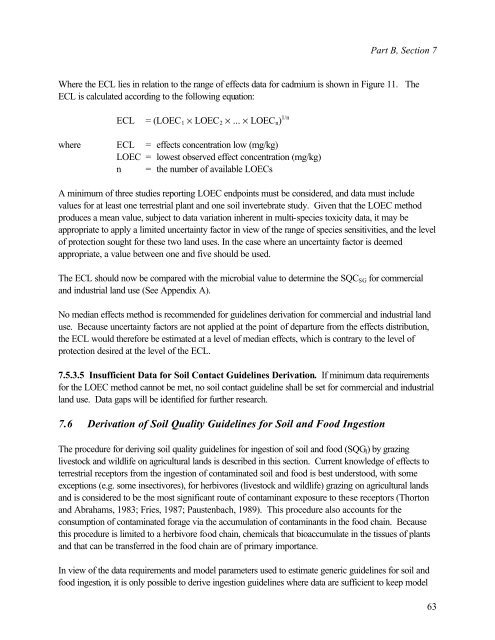Protocol for the Derivation of Environmental and Human ... - CCME
Protocol for the Derivation of Environmental and Human ... - CCME
Protocol for the Derivation of Environmental and Human ... - CCME
You also want an ePaper? Increase the reach of your titles
YUMPU automatically turns print PDFs into web optimized ePapers that Google loves.
Part B, Section 7<br />
Where <strong>the</strong> ECL lies in relation to <strong>the</strong> range <strong>of</strong> effects data <strong>for</strong> cadmium is shown in Figure 11. The<br />
ECL is calculated according to <strong>the</strong> following equation:<br />
ECL = (LOEC 1 × LOEC 2 × ... × LOEC n ) 1/n<br />
where ECL = effects concentration low (mg/kg)<br />
LOEC = lowest observed effect concentration (mg/kg)<br />
n = <strong>the</strong> number <strong>of</strong> available LOECs<br />
A minimum <strong>of</strong> three studies reporting LOEC endpoints must be considered, <strong>and</strong> data must include<br />
values <strong>for</strong> at least one terrestrial plant <strong>and</strong> one soil invertebrate study. Given that <strong>the</strong> LOEC method<br />
produces a mean value, subject to data variation inherent in multi-species toxicity data, it may be<br />
appropriate to apply a limited uncertainty factor in view <strong>of</strong> <strong>the</strong> range <strong>of</strong> species sensitivities, <strong>and</strong> <strong>the</strong> level<br />
<strong>of</strong> protection sought <strong>for</strong> <strong>the</strong>se two l<strong>and</strong> uses. In <strong>the</strong> case where an uncertainty factor is deemed<br />
appropriate, a value between one <strong>and</strong> five should be used.<br />
The ECL should now be compared with <strong>the</strong> microbial value to determine <strong>the</strong> SQC SG <strong>for</strong> commercial<br />
<strong>and</strong> industrial l<strong>and</strong> use (See Appendix A).<br />
No median effects method is recommended <strong>for</strong> guidelines derivation <strong>for</strong> commercial <strong>and</strong> industrial l<strong>and</strong><br />
use. Because uncertainty factors are not applied at <strong>the</strong> point <strong>of</strong> departure from <strong>the</strong> effects distribution,<br />
<strong>the</strong> ECL would <strong>the</strong>re<strong>for</strong>e be estimated at a level <strong>of</strong> median effects, which is contrary to <strong>the</strong> level <strong>of</strong><br />
protection desired at <strong>the</strong> level <strong>of</strong> <strong>the</strong> ECL.<br />
7.5.3.5 Insufficient Data <strong>for</strong> Soil Contact Guidelines <strong>Derivation</strong>. If minimum data requirements<br />
<strong>for</strong> <strong>the</strong> LOEC method cannot be met, no soil contact guideline shall be set <strong>for</strong> commercial <strong>and</strong> industrial<br />
l<strong>and</strong> use. Data gaps will be identified <strong>for</strong> fur<strong>the</strong>r research.<br />
7.6 <strong>Derivation</strong> <strong>of</strong> Soil Quality Guidelines <strong>for</strong> Soil <strong>and</strong> Food Ingestion<br />
The procedure <strong>for</strong> deriving soil quality guidelines <strong>for</strong> ingestion <strong>of</strong> soil <strong>and</strong> food (SQG I ) by grazing<br />
livestock <strong>and</strong> wildlife on agricultural l<strong>and</strong>s is described in this section. Current knowledge <strong>of</strong> effects to<br />
terrestrial receptors from <strong>the</strong> ingestion <strong>of</strong> contaminated soil <strong>and</strong> food is best understood, with some<br />
exceptions (e.g. some insectivores), <strong>for</strong> herbivores (livestock <strong>and</strong> wildlife) grazing on agricultural l<strong>and</strong>s<br />
<strong>and</strong> is considered to be <strong>the</strong> most significant route <strong>of</strong> contaminant exposure to <strong>the</strong>se receptors (Thorton<br />
<strong>and</strong> Abrahams, 1983; Fries, 1987; Paustenbach, 1989). This procedure also accounts <strong>for</strong> <strong>the</strong><br />
consumption <strong>of</strong> contaminated <strong>for</strong>age via <strong>the</strong> accumulation <strong>of</strong> contaminants in <strong>the</strong> food chain. Because<br />
this procedure is limited to a herbivore food chain, chemicals that bioaccumulate in <strong>the</strong> tissues <strong>of</strong> plants<br />
<strong>and</strong> that can be transferred in <strong>the</strong> food chain are <strong>of</strong> primary importance.<br />
In view <strong>of</strong> <strong>the</strong> data requirements <strong>and</strong> model parameters used to estimate generic guidelines <strong>for</strong> soil <strong>and</strong><br />
food ingestion, it is only possible to derive ingestion guidelines where data are sufficient to keep model<br />
63
















